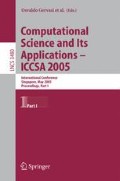Abstract
Distributed Virtual Environments (DVEs) are distributed systems that allow multiple geographically distributed clients to interact concurrently in a shared virtual world. In practice, a multi-server architecture is usually employed as the communication architecture for DVEs, and the virtual world is partitioned into several zones to distribute the load among servers. A new problem, termed client allocation, arises when assigning the participating clients to servers. Current approaches usually assign clients to servers according to the locations of clients in the virtual world, i.e., clients interacting in a zone will be assigned to the same server. However, if the network delay from a client to its assigned server is large, the interactivity of the application may be greatly degraded. In this paper, we formulate the client allocation problem, and propose some allocation algorithms to assign clients to servers in DVEs in a more efficient way, taking into account both the virtual locations of clients and the network delays between clients and servers. Simulation results show that our algorithms are effective in enhancing the interactivity of DVEs.
Access this chapter
Tax calculation will be finalised at checkout
Purchases are for personal use only
Preview
Unable to display preview. Download preview PDF.
References
Singhal, S., Zyda, M.: Networked Virtual Environments. Addison-Wesley, New York (1999)
Dias, J., Galli, R., Almeida, A., Belo, C., Rebordao, J.: mWorld: A Multiuser 3D Virtual Environment. IEEE Computer Graphics 17(2) (1997)
Miller, D., Thorpe, J.: SIMNET: The advent of simulator networking. Proc. of the IEEE 83(8) (1995)
Nitta, T., Fujita, K., Cono, S.: An Application of Distributed Virtual Environment to Foreign Language. IEEE Education Society (2000)
Smed, J., Kaukoranta, T., Hakonen, H.: Aspects of Networking in Multiplayer Computer Games. In: Proc. of the International Conference on Application and Development of Computer Games in the 21st Century (2001)
Zona Inc. and Executive Summary Consulting Inc.: State of Massive Multi-player Online Games 2002: A New World in Electronic Gaming (2002), Available at http://www.zona.net
Das, T.K., Singh, G., Mitchell, A., Kumar, P.S., McGee, K.: NetEffect: A Network Architecture for Large-Scale Multi-User Virtual Worlds. In: Proc. of the ACM VRST (1997)
Cronin, E., Filstrup, B., Kurc, A.: A Distributed Multiplayer Game Server System. Technical Report, University of Michigan (2001)
Sony Online Entertainments: Everquest, Available at http://eqlive.station.sony.com
Lee, K.W., Ko, B.J., Calo, S.: Adaptive Server Selection for Large Scale Interactive Online Games. In: Proc. of NOSSDAV (2004)
Abdelkhalek, A., Bilas, A., Moshovos, A.: Behavior and Performance of Interactive Multi-player Game Servers. Special Issue of Cluster Computing: the Journal of Networks, Software Tools and Applications (2002)
Morillo, P., Orduna, J.M., Fernandez, M., Duato, J.: On the Characterization of Distributed Virtual Environment Systems. In: Kosch, H., Böszörményi, L., Hellwagner, H. (eds.) Euro-Par 2003. LNCS, vol. 2790, pp. 1190–1198. Springer, Heidelberg (2003)
Lui, J., Chan, M.: An Efficient Partitioning Algorithm for Distributed Virtual Environment Systems. IEEE Transaction on Parallel and Distributed Systems 13(3) (2002)
Ta, D.N.B., Zhou, S.: A Dynamic Load Sharing Algorithm for Massively Multi-Player Online Games. In: Proc. of the 11th IEEE International Conference on Networks (2003)
Cai, W., Xavier, P., Turner, S., Lee, B.S.: A Scalable Architecture for Supporting Interactive Games on the Internet. In: Proc. of the 16th Workshop on Parallel and Distributed Simulation (2002)
Fujikawa, K., Hori, M., Shimojo, S., Miyahara, H.: A Server Selction Method based on Communication Delay and Communication Frequency among Users for Networked Virtual Environments. In: Jean-Marie, A. (ed.) ASIAN 2002. LNCS, vol. 2550, pp. 125–139. Springer, Heidelberg (2002)
Cardellini, V., Colajanni, M., Yu, P.S.: Geographic Load Balancing for Scalable Distributed Web Systems. In: Proc. of MASCOTS (2000)
Author information
Authors and Affiliations
Editor information
Editors and Affiliations
Rights and permissions
Copyright information
© 2005 Springer-Verlag Berlin Heidelberg
About this paper
Cite this paper
Ta, D.N.B., Zhou, S. (2005). Client Allocation for Enhancing Interactivity in Distributed Virtual Environments. In: Gervasi, O., et al. Computational Science and Its Applications – ICCSA 2005. ICCSA 2005. Lecture Notes in Computer Science, vol 3480. Springer, Berlin, Heidelberg. https://doi.org/10.1007/11424758_98
Download citation
DOI: https://doi.org/10.1007/11424758_98
Publisher Name: Springer, Berlin, Heidelberg
Print ISBN: 978-3-540-25860-5
Online ISBN: 978-3-540-32043-2
eBook Packages: Computer ScienceComputer Science (R0)

